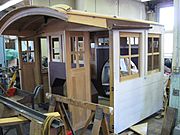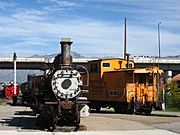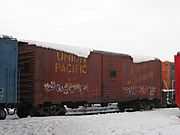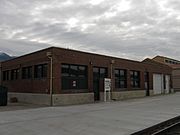Rio Grande 223 facts for kids
Quick facts for kids D&RGW 223 |
|
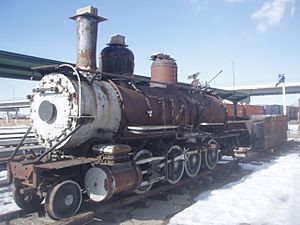 |
|
| #223 undergoing restoration in 2010 | |
| Power type | Steam |
|---|---|
| Reference | |
| Builder | Grant Locomotive Works |
| Serial number | 1436 |
| Build date | December 1881 |
| Total production | 53 (Grant-28) (Baldwin-25) |
| Configuration | 2-8-0 |
| UIC classification | 1′D n2 |
| Gauge | 3 ft (914 mm) |
| Driver diameter | 37 in (940 mm) |
| Weight on drivers | 59,330 lb (26.9 t) |
| Locomotive weight | 69,105 lb (31.3 t) |
| Fuel type | Coal |
| Cylinders | Two |
| Cylinder size | 15 in × 20 in (381 mm × 508 mm) |
| Number in class | 53 |
| Retired | 1941 (revenue service) |
| Restored | 1992–ongoing |
| Current owner | 1952: Salt Lake City 1979: Utah State Historical Society 1992: Utah State Railroad Museum |
| Disposition | Undergoing restoration to operating condition, based in Ogden, Utah at Union Station |
|
Grant Steam Locomotive No. 223
|
|
| Location | Union Station, Ogden, Utah |
| Area | 1 acre (0.40 ha) |
| Built | 1881 |
| Architect | Grant Locomotive Works |
| Architectural style | Consolidation type 2-8-0 Class C-16-60 |
| NRHP reference No. | 79002501 |
| Added to NRHP | May 23, 1979 |
The Denver and Rio Grande Western 223 is a special type of steam train called a "Consolidation" locomotive. It was built in 1881-1882 by the Grant Locomotive Works in Paterson, New Jersey. This train was made for the Denver and Rio Grande Railroad.
Locomotive 223 was finished in December 1881. It cost $11,553 to build. Another company, Baldwin Locomotive Works, built 25 more trains of the same type around the same time.
Contents
Train's Working Life
Some people thought that the 223 train worked in Utah. This was because the D&RGW had narrow-gauge tracks there until 1890. However, experts later found that the 223 was never actually used in Utah.
Fires and Collisions
On December 11, 1892, the Denver & Rio Grande's train shops in Salida caught fire. The fire started in another train, No. 419. It quickly spread because the floor was soaked with oil. The city's fire hydrants were off due to cold weather. The whole shop burned down, and the 223 train was damaged. Luckily, the 223 was rebuilt soon after and put back to work.
Just 13 years later, on January 17, 1905, the 223 was in another fire. This time it happened in Gunnison. The 223 and another train, No. 218, both burned. Both trains were rebuilt. The 223 even got a new water tank in April of that year.
The Rio Grande Southern Railway sometimes rented trains from the D&RG. In 1907, the 223 and other similar trains were sent to the RGS. They were returned to the D&RG in 1922. On September 12, 1922, the 223 crashed into train No. 222 in Chama, New Mexico. No one kept records of how much damage was done to either train.
Final Years of Service
The 223's last known job was on July 4, 1940. Photos taken by Otto Perry show it working on the 18-mile Baldwin Branch. This branch had old wooden bridges. Because of the bridges' weight limits, only lighter trains like the C-16s (which included the 223) could use this track. The 223 worked on this part of the D&RGW from 1937 until it stopped working.
Most trains like the 223 were retired by the 1920s or 1930s. Only one, No. 268, stayed in service until 1955. The 223 train was taken out of service in 1941.
Journey to Utah
After it stopped working, the railroad rented the 223 to Salt Lake City. This started with the Pioneer Day celebration in 1941. In 1952, the train was officially given to the city as a gift. Before it went to Salt Lake City, the 223 was given a fake "diamond stack" smokestack and an old 1880s paint job.
There was a popular story that the 223 was moved on a special train pulled by four new FT locomotives. But this was a myth caused by wrong photo captions. A historian named Jerry Day found that it was actually train No. 268 that was moved on that special train, not the 223. In 1952, after the train was given to the city, the railroad's Salt Lake City shops removed the fake smokestack and old headlight. They repainted the 223 in its 1930s "button herald" style.
Along with the 223, a narrow-gauge boxcar, caboose, and gondola car were sent to Pioneer Village. This village was at the Lagoon Amusement Park in Farmington, Utah. These cars were later stored in Ogden. They were in bad shape and were sadly destroyed in a fire in 2006.
Sitting in the Park
The 223 sat outside in Liberty Park for many years. The weather and vandalism slowly damaged it. In 1979, the city gave the train to the Utah State Historical Society. An expert was asked to figure out how much it would cost to fix the train. But there wasn't enough money for the project.
So, in 1992, the train was moved again. This time it went to the Utah State Railroad Museum. The 223 was stored behind a candy factory building. In 2006, the candy factory caught fire and burned down. Three narrow-gauge freight cars were also destroyed. Luckily, the train's cab (the part where the engineer sits) had already been removed before the fire.
The 223 was then moved to its current spot. It is now at the north end of the Utah State Railroad Museum complex. This is next to the restoration shop at Union Station in Ogden, Utah. Some restoration work has been happening there. The tender (the car that carries coal and water) and the cab are inside the museum's shop. The rest of the train is outside.
For a long time, people thought the train's frame and rods were bent badly during its 1979 move. They believed this meant the wheels could no longer turn. However, after looking at old photos, it was found that the rods were actually bent on purpose. This happened when the train was on display at Liberty Park. The track there sloped downhill, and there were no stops to keep the train from rolling away. The rods were bent to prevent it from moving. The train's boiler is in very poor condition. It sat outside for 50 years with wet asbestos around it. The tender is being completely replaced.
Restoring the Train
Restoration work on the 223 is being done by a group called the Golden Spike Chapter of the Railway & Locomotive Historical Society. They work in the old Trainman's Building at the north end of the Ogden Union Station. You can see them working on Saturday mornings.
The restoration started in 1992. At first, they used a boxcar as a small workshop. The group soon needed more space. After the candy factory fire in 2006, they were given the Trainman's Building. Ogden City paid for roof repairs, an alarm system, and lights. Then, the restoration work moved indoors. At the same time, the 223 was moved from behind the candy factory to its current spot outside the shop.
Today, the wooden cab is finished. Many of the train's parts have been repaired. Work on the tender is almost done. As of 2010, workers were riveting the tender's tank. This involved drilling over 3,000 holes by hand! The Golden Spike Chapter works as they get money. This means the restoration is slow but steady.
In 1979, the train was added to the National Register of Historic Places. It is listed as Grant Steam Locomotive No. 223.
130th Anniversary Celebration
The year 2011 was special for the 223. It marked 130 years since the train was built (1881–2011). It was also 70 years since the 223 stopped working (1941). And it was 20 years since it moved to Ogden from Salt Lake City.
To celebrate, the Golden Spike Chapter started uploading videos to YouTube. These videos show important moments in the 223's recent history. This includes its move from Salt Lake City in 1991 and the 2006 Candy Factory Fire. The 130th anniversary was also featured in a magazine called the Colorado Time-Table in December 2010.






